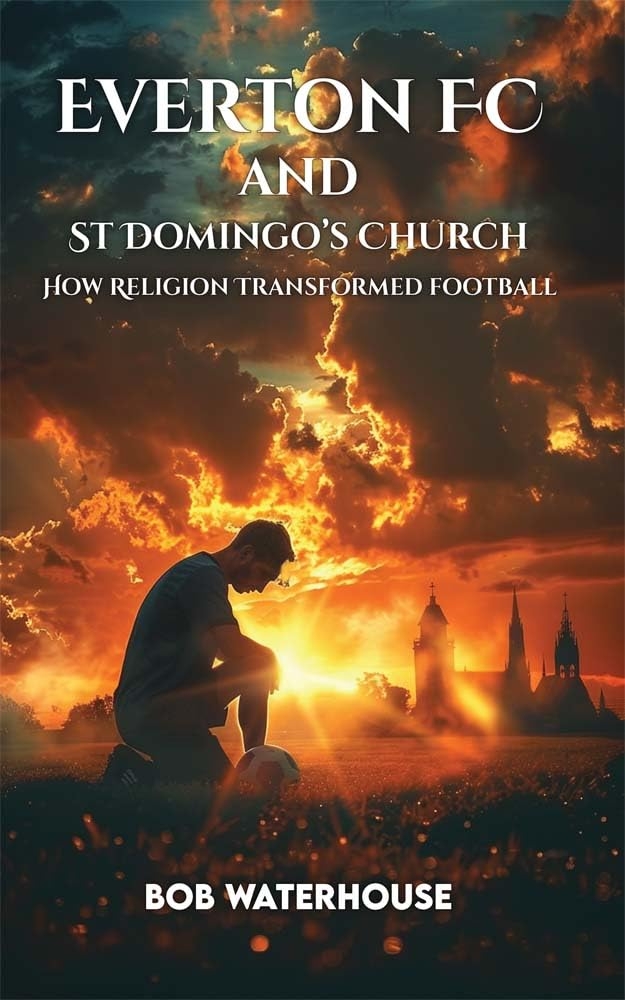Football didn’t just happen. It didn’t magically appear on the streets of Victorian Britain or grow out of factory smoke and public-school rivalries. It started with faith, conviction, and a group of religious reformers who believed sport could rebuild the moral backbone of a changing world.
Bob Waterhouse’s new book, Everton FC and St. Domingo’s Church: How Religion Transformed Football, uncovers that hidden origin story, and proves the church’s fingerprints are still all over the modern game.
The Movement That Turned Churches into Training Grounds for a New Society
Waterhouse cuts straight to the root: Muscular Christianity, a movement that believed discipline, teamwork, fitness, and moral courage could save young men from drifting away from faith. Ministers, youth leaders, and reformers grabbed the football and ran with it. They used it to reach working-class men who felt shut out of Victorian church culture.
That belief didn’t just spark new clubs. It reshaped entire communities and set the stage for the sport the world is obsessed with today.
The Small Methodist Chapel That Accidentally Rewrote Football History
Every Everton fan knows the name St. Domingo’s… but few understand just how deep its impact runs.
Waterhouse digs into the origins of Everton FC inside that modest Methodist chapel, challenges the revisionist historians who tried to downplay its influence, and maps the political tensions, especially around temperance and class, that eventually split Everton and created Liverpool FC.
The story reveals something bigger: religion wasn’t just part of the club’s history. It was the engine that drove its birth.
The Global Spread of Football Wasn’t Just Trade It Was Missionary Work in Disguise
One of the book’s most compelling threads is how British teachers, clergy, and missionaries exported football across continents long before it became a global business.
Waterhouse showcases figures like:
➔ Alexander Watson Hutton in Argentina, who built the country’s first league through elite schools.
➔ Charles Miller in Brazil, whose suitcase full of footballs and rulebooks ignited an entire nation’s sporting identity.
➔ Missionary schools in Ghana, Uganda, Nigeria, India, and Chile, where football became a tool for education, discipline, and sometimes even social reform.
➔ Jewish and Catholic movements that built clubs to strengthen cultural identity, from Hakoah Vienna to Glasgow Celtic.
Football didn’t spread because it was simple. It spread because people believed it could shape character.
When Professionalism Hit Football Hard, the Church Lost Control, but the Influence Never Died
Waterhouse pulls no punches in showing how professionalism shook the Church-sport relationship.
Gambling, soaring wages, corruption scandals, match-fixing, everything the early clergy feared came true. Most churches backed away. Club names changed. Religious branding faded.
But here’s the twist: faith didn’t disappear. It evolved.
➔ Chaplains now support Premier League players behind the scenes.
➔ Faith-based community programs mirror 19th-century social-reform missions.
➔ Stars like Bukayo Saka express their faith openly.
➔ Grassroots Christian, Muslim, Sikh, and Jewish teams thrive across the UK.
➔ Global debates, like hijab bans in sport, prove religion still shapes football’s moral landscape.
The church may have stepped back. But it never stepped out.
Liverpool in the 1870s Shows What Happens When Religion, Politics, and Sport Collide
Waterhouse’s reconstruction of 19th-century Liverpool is one of the book’s strongest pieces of storytelling. The city’s low church attendance, rapid urbanisation, and political tensions created a perfect storm.
Inside that storm, Everton’s identity was forged. Temperance movements, Liberal–Conservative rivalries, and competing church traditions all played roles in shaping the club’s future, and tearing it apart. The book doesn’t just revisit history. It reframes the founding myth.
A Final Question That Changes How We See the Game
Waterhouse ends with a powerful idea:
If football began as a religious project, what has it become now?
For millions of fans, it looks and feels like a belief system, rituals, devotion, community, pilgrimage, sacred grounds, and all. In many places, the club replaced the church as the heart of local identity.
That comparison isn’t exaggerated. It’s earned. And after reading this book, it’s impossible to ignore.
About the Author
Bob Waterhouse, supported by research assistance from Liverpool’s Picton Library and academic advisor Philip Garrahan, brings together decades of historical insight with a storyteller’s instinct. This is not a dry archive dive; it’s a compelling narrative about culture, faith, identity, and the surprising forces that shape the modern world.
A Book That Rewrites Football’s Origin Story
Everton FC and St. Domingo’s Church: How Religion Transformed Football is more than a history book. It’s a revelation. A challenge to long-held assumptions. And a must-read for anyone who believes football is more than just 90 minutes and a final score.
Contact
For interviews, review copies, or press enquiries, contact: The Empire Publishers
Media Contact
Company Name: The Empire Publishers (USA)
Contact Person: Iris Williams
Email: Send Email
Country: United States
Website: https://www.theempirepublishers.com/

